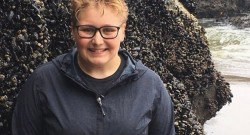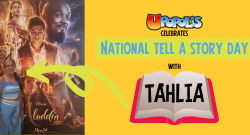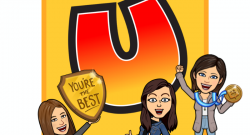Uncategorized
Sign up today for U Got This! A Workshop to help youth take control of their life during times of uncertainty
In May 2020, we introduced the U Got This! Challenge, a weeklong virtual activity series to help youth cope with the challenges associated with COVID-19. We’re excited to announce we’re doing it again, starting October 18th! This time, we’re helping youth “embrace control” with a 4-week activity series led by our team. The goal is to help youth find and gain back a sense of control, a feeling often lost during hard times (like during a worldwide pandemic!)
Here’s what our series has to offer:
- 4 activities sent out via e-mail on the Monday of each week beginning October 18th, 2021
- E-mails will contain everything youth need to participate in the activity virtually: a video lesson, handouts, and any other important information!
- Participants will be invited to work on photo projects, art pieces, coping skills and t-shirt designs
A little sneak peek into our weekly themes…
Emotions – ready to test your photography/videography skills! How do you channel your emotions so that they don’t become unhealthy?
Mantras – it’s time to get creative. What’s your life mantra?
Past, present and future – do you love art? Learn to find control in your life while making a masterpiece!
Physical coping – dive into how our bodies physically respond during times of stress, and what you can do to help!
Youth do not have to be part of our Upopolis community to join, the workshop is FREE, and it is facilitated entirely by certified child life specialists who are trained to support children and youth through life’s challenging events.
Do you want to take part, or know a youth who would benefit? E-mail support@upopolis.com to let the team know, “I want in!”
How can I help a grieving youth transition back to school?
With school just around the corner, you may be wondering how you can support a youth who, in addition to dealing with the ongoing uncertainty of Covid-19, has also experienced the death of someone significant. Whether the plan is to attend school in person or remotely, one thing is clear: youth who are grieving need caring adults in their lives to start the conversation and help plan for a smoother return to the classroom.
Not sure where to start? Below, we highlight various resources designed to help caregivers, educators, and other potential supports connect with youth who are grieving.
- Kidsgrief.ca on the Canadian Virtual Hospice website offers modules created for both parents and educators with guidance on how to talk with children and youth about serious illness, dying and death. Particularly, KidsGrief.ca for educators discusses how to apply strategies to help students cope with Covid-19 related impact, death, and grief.
- Lighthouse has created these short but effective tip sheets that can be used to help prompt discussion:
Returning to school after a death – how you can help provides suggestions on how caregivers can make this transition easier. When possible, caregivers can help by talking to the youth’s teachers and school counsellor, making a communication plan around what information the youth would like to share and how, preparing the youth for other students’ questions or comments, identifying trusted supports in the school setting, rehearsing coping strategies, and importantly, giving the youth permission to have fun again.
Supporting a grieving child or teen at school identifies signs of a grieving student, and ways teachers and school staff can assist. These include educators reaching out to the family before the student returns to school, creating a support plan to help the youth manage triggers and emotionally difficult days, and fostering a grief friendly classroom by providing opportunities to express feelings and emotions. Be sure to share this poster with the educators in your youth’s life: 20 Things grieving students would like teachers to know.
- Social support at school is paramount so involve peers! Your friend is grieving, tips for supporting them created by the Dougy Center gives concrete ideas on how to show up for a friend who is navigating loss. Be sure to share this with the students you work with if you are an educator or alternately, as a caregiver you can encourage the youth who is grieving to share this with friends.
- Lastly…sometimes it’s hard to know how best to support a youth depending on the individual circumstances. Attend a free online Q&A with child and youth grief expert Andrea Warnick. On the first Tuesday of every month from 1:00-2:00pm ET, you can join in and ask your own questions or listen to and learn from other’s grief experiences. Just register here. Or if you have a question about terminal illness, end-of-life care, loss, or bereavement, you may be interested in checking out Canadian Virtual Hospice’s Ask a Professional. Their team of palliative care experts will provide a detailed, personal response within three working days – and no need to worry, all questions and answers are kept confidential.
With so many available resources at your fingertips, you can be sure that you’re helping the youth in your life start the new school year on the right note. While losing a loved one is never easier, it’s always a little bit easier knowing there’s people around who care.
7 tips for Transitioning into the Adult Health Care System… by Maggie, a Upopolis UMentor!
Do you know a youth who is soon transitioning from pediatric to adult health care? We were so excited to have Maggie, a past Upopolis user, young adult, and UMentor join us for this month’s blog post on just that! Transitioning into the adult health care world.
Maggie joined Upopolis almost ten years ago, soon after it’s inception, and became an avid member. During her years on Upopolis, she went from being a youth user to a UPal (taking on a more leadership role), and is now a UMentor. A UMentor is a youth turned young adult who has transitioned out of pediatrics and comes online to help our current youth cope with their own transition.
Read her 7 tips for making the transition smooth:
“For those with complex and chronic health conditions, going to appointments at the hospital can become routine. We are fortunate to have tertiary pediatric health care across Canada, but it can be easy to forget how unique the Children’s Hospitals are run until your time in the system comes to a close. Every family dreads the time when the transition between child-centered to adult-oriented health care has to occur, but it doesn’t always have to be a negative experience. Unfortunately, my transition was somewhat abrupt due to the COVID-19 pandemic. Nevertheless, I would like the share some tips and tricks that I have learned along the way:
- Advocate for yourself and make sure your voice is heard. Make sure you go over your history thoroughly and tell your doctors what works for you and what doesn’t.
- Ask lots of questions, you have a right to know exactly what is happening. Bring a notepad to write notes or even a friend/family member who can also listen in.
- Be honest with where you’re at and how your health is affecting your life. Nobody knows your body better than you.
- Build a relationship with your new care team. It is important for your medical team to know who you truly are and what drives your determination.
- Let yourself be okay with change. Be open to letting new people in on your health journey whether that be doctors, nurses, respiratory therapists, etc…
- Talk about the transition before it happens. Outline what you want to see before, during, and after transition to keep yourself accountable.
- Reach out to your child life specialist in person or through Upopolis as they are equipped to help ease the transition and often have incredible tips.
I hope that these points are helpful to others. While it can be daunting, it is a necessary next step in your medical journey. Keep your head up and make sure your voice is heard when discussing your health.
Show Maggie some love by sharing this post to social!
Helping youth navigate grief online
Have you seen our published article on the TELUS Wise website?
TELUS Wise is a free education program that offers Canadians of all ages access to resources and workshops (again, at no charge!) to help promote positive digital literacy and online safety.
They have tons of blog posts, workshops, resources and tips to help children, youth and adults navigate the online world.
We joined them with our latest article about helping youth navigate their grief in the online world. Check it out here: https://www.telus.com/en/wise/resources/content/article/helping-youth-navigate-grief-online
For more information about TELUS Wise and to access their free education programs and resources, visit their website: https://www.telus.com/en/wise
“My double lung transplant journey… over the last 9 years!!”
If you didn’t know already, we know some pretty incredible youth on Upopolis.
Just when you think you’re having a hard day, you hear about the incredible journeys these youth have been through and then you think, “If they can go through challenges like these, then I can get through my day.” The most amazing part? They have been through some really intense experiences and have come out of them stronger and smarter. They are some of the most compassionate, insightful, empathetic and brilliant youth we know.
In honour of National Tell a Story day on April 27th, we invited one youth in particular, Tahlia, to share her story with us about her double lung transplant through the COVID-19 pandemic. We featured her on our social media pages for our #UpopolisUser spotlight, a monthly showcase of the awesome youth on our website, and now, we get to hear the rest of her powerful journey. Read below!
“I was diagnosed with pulmonary hypertension (PH) and 2 ASDs/holes in my heart at the age of 6 turning 7. I was recommended to come to [a city half way across the country] by another family with a kid with PH because there are specialists there that provide better care. My health was doing really well for 9 years, which is impressive for PH as it does go undiagnosed/misdiagnosed as asthma and at that point is difficult to treat.
In 2019 my health took a turn and I was put on a subcutaneous pump 24/7 hoping it would give me some more time. Sadly it didn’t do anything for me. I was a bit disappointed because they told me I’d have more energy to do the things I loved, but it actually took it away because I was told I wasn’t allowed to do them anymore. In September 2019 my PH specialist recommended that we look into a double lung transplant and that I get assessed for transplant. In January 2020 we made a week trip back [across the country] to get assessed for a double lung transplant.
In February 2020 we found out I was eligible for transplant and was told to be ready for May 1st. Due to COVID, though, my transplant was put on hold.
Now was the waiting game for another call for transplant.
We waited until November 13, 2020 and that was the day we got the call! But transplant didn’t happen until November 16. The day I got the call for transplant I was full of mixed emotions because I wasn’t quite prepared. I had nothing packed, I was stressed because I didn’t really know what to expect but then when I found out I was still waiting. It caused more reactions because we thought it might not happen, but it did!
I was in the intensive care unit (ICU) for 2 weeks because they thought I could have possibly caught something, and I almost had to be put back on a ventilator.
After 2 weeks in ICU I was sent to the ward to do physiotherapy every day. I was trying to gain leg strength, but due to having been in the ICU for 2 weeks my legs were not as strong as they would have liked. They sent me to a rehabilitation center for 2 months to strengthen my legs. They got pretty strong really quickly!
Here we are now getting ready to go back home at the beginning of June 2021. Getting the transplant was a miracle. It changed my life forever. I was able to do the things I loved like singing and dancing again. It was a huge step forward because before transplant it was very difficult to do without running out of breath or being in pain. Now I’m able to do all that without suffering and I’m finally able to enjoy it.
On Upopolis I feel like they’re my second family! There’s kids dealing with similar challenges as me! I really enjoy making new friends on Upopolis and all the game nights. “
Editor’s note: Identifying information about where Tahlia’s healthcare took place has been removed for confidentiality/privacy reasons.
Definitions
Pulmonary hypertension: increased blood pressure in the lungs
ASD (atrial septal defect): a hole in the wall between two areas of the heart
Subcutaneous pump 24/7: a small machine that gives the body medicine all day and night to help with pulmonary hypertension and ASD
Double lung transplant: doctors remove both lungs, one at a time while the body is asleep, and puts new ones in. This usually takes between 6 – 8 hours.
Intensive care unit: an area of the hospital where patients receive healthcare from a nurse that is dedicated to them. In other areas, nurses can have 2 – 4 patients.
The role of child life ONLINE! What does a child life specialist do on Upopolis?
Kids’ Health Links Foundation employed child life specialists online long before the COVID-19 pandemic was a thing. 12 months ago, if you didn’t know about Upopolis you probably would have wondered what there is for a child life specialist to do virtually. How do you support children and youth through a computer?
Whether you’ve started to provide support to patients and families online or not, you’ve certainly been hearing more and more about it. Through webinars, from colleagues, on social media. Meeting patients over video chats and learning how to prepare, educate, and empower children and youth through a computer… it’s hard work! And we’re all learning to navigate it together.
Upopolis though, it’s different. 90% of the time our small team of child life specialists are providing support to youth aged 10 – 18 years through a keyboard and computer, no video chats included. We’re typing, posting, creating, planning… mostly providing therapeutic content without ever seeing a youth in real time!
If you’re a veteran child life specialist, you understand how transferable child life skills are. But if you’re new to the field and are learning how far your child life skills can expand, we’ll you’ve come to the right place for an inside scoop.
Privacy
On Upopolis, the number one priority is the safety of the youth users. Our National Program Manager works closely with key players to make sure the website is always up to date and technology bugs are identified and fixed quickly. Along with our Program Coordinator and social media lead, our team is always making sure consents across the website are up to date and user-friendly. If a media consent form needs to be sent to a family to approve a photo being posted online, the consent needs to be easy to read and understand. The privacy of children and youth is so important, and child life specialists have a keen eye for that.
Content Planning
This goes without saying, content across all of Upopolis (in our spaces, on our social platforms, for virtual meet ups) is planned with a child life eye. Our Program Coordinator is constantly updating, reviewing and adding content to our spaces for youth to access if they’re in need of diagnosis explanations or procedural preparation; she is also always planning ways to engage our youth users to help empower them, encourage socialization, and teach them lifelong skills. As our youth post online, our team is there to answer them. If a youth posts about being nervous for an upcoming appointment, one of our child life specialists will respond.
Our National Program Manager develops resources to help our users with their coping skills, to offer to parents and child life specialists (especially via our podcast), and is always reviewing branding to make sure our content is easy to understand. And of course, the infographics we post on our social platforms, the Tik Toks we create, and the tips we share, all have the goal to help youth cope with their diagnoses or hospitalization and help parents help their children navigate illness.
Social Media
Child life on social media certainly isn’t a new thing, but there is so much to think about in order for it to be appropriate and successful. Our social lead is always online reviewing comments and posts, responding back to messages from our youth, and helping the community navigate our site. There is a need for customer service, and for child life specialists, it’s innate. Not to mention, privacy is always top of mind, as is creating content that will educate our youth and followers, and empower them to be the best version of themselves, no matter the circumstance.
If you want to learn more about our website, follow and stay tuned to our social media accounts to learn about our upcoming Tour Q&As with our National Program Manager!
Youth Takeover! “The Social Model, Oversimplified” by Caelin
The way both disabled, and non-disabled people view disability can vary greatly. Different people with different mindsets, upbringings, lived or learned experiences & confidence levels; these things all shape how a person views disability. Generally, people’s views of disability fall into one of two categories: the medical model, and the social model.
In brief, in the medical model of disability, the person is disabled by their impairment, and emphasis is placed on a ‘cure’ or ‘almost cure.’ The person should adapt to their world. The medical model can create a mindset completely focused on cure and may cause people to feel broken or less-able.
In the social model, ‘disabled’ and ‘impairment’ are not the same. This model says that the person is not disabled by their impairment, but rather, their environment or society that is not accessible to them. It means disabled people are seen as equals and looked at for their abilities and meaningful achievements.
For example, under the social model, if I’m in a restaurant that has an electronic menu, I am not disabled in that situation; if they didn’t have an accessible menu, I am disabled in that situation, because the environment isn’t accessible to me, not because of my visual impairment. If I’m in class, and I’m not provided with digital materials, I am disabled because they’re not accessible.
I subscribe to the social model. It’s very freeing and solidifies that I am not the problem or in need of a cure, but society should be made accessible to me. Not only that, but able-bodied have a genuine, selfish interest in universal design as well, known as the ‘curb cut phenomenon;’ curb cuts help people in wheelchairs, but also cyclists, skateboarders, and parents pushing baby strollers. We all benefit when everyone is given equitable access.
Caelin is a Upopolis user. He has oculocutaneous albinism, which causes his eyes to have light sensitivity, poor visual acuity and no depth perception. Caelin has been teaching us about visual impairment since he joined Upopolis, and has also kept us laughing with his jokes and humour!
5 interventions to get the youth in your life TALKING!
Sometimes, as an adult, it may be challenging to connect with youth. As youth grow older, they’re finding their independence. It’s natural for them to begin to explore relationships with friends and themselves. They’re interested in things we have trouble relating to and sometimes it’s as though they can’t even be bothered talking to us!
However, research show youth who share their emotions have better mental health. They’re more likely to talk openly about any problems they might be facing in their life, which gives us the opportunity to help them with cope with these challenges.
On Episode 10 of the Upopolis Podcast, our host Krista Naugler offers 5 therapeutic interventions for youth. With over 24 years of experience working with youth in many settings, Krista is able to identify her tools of the trade for helping youth connect with themselves, with others, and with you!
Whether you’re a child life specialist, parent, teacher, or service provider in the community, you’ll find these interventions helpful for your practice. Read on to learn the top 5 that Krista suggests using when working with youth:
1900’s texting – who are the people that make up this youth’s support system?
We know youth are into their devices, so meet them where they’re at. For this intervention, you can either use a real device or use old school pen and paper.
Have the youth write down something that they would like to say to someone who has been there for them, sort of like a note of thanks or acknowledgement. Then have them read the note to that person or send them the actual text. This gives them an opportunity to reflect on the supports they have available and to practice sharing with those people their feelings and gratitude. Bonus, they’ll see how touched everyone is to receive a note of thanks!
Fingerprint stories – helping our youth share a story, thought or feeling
This intervention requires an ink pad and a photo copier. Make an ink print of the youth’s finger or thumb print, then photocopy and enlarge it until it fills the better part of an 8×10”
paper. Place a blank white piece of paper over top of the enlarged photocopy and place on a window or lightboard (you may need tape). Give the youth a theme and have them write a story following the lines of their fingerprint. They can write about their experiences, feelings, dreams, an adventure, or a theme related to a goal you have for them. Once they have filled the fingerprint lines with their story, remove it from the light source and decorate it!
Learning from our youth – connect with them by having them teach you something
Ask the youth to teach you something new, like a favourite game they have! This helps them be the expert in something and gives them back a sense of control. An alternative is learning something new together, like coding. This provides them with something to learn and focus on, which is especially helpful if you need to encourage them to focus their time and energy into something positive.
Graphic design – youth can express themselves or educate others
There are TONS of apps and web-based programs for creating graphics; PicCollage, Canva and Smilebox to name a few. Helping youth design things like t-shirt logos, recipe cards and journal pages gives them an expressive outlet. It’s also another way to help youth feel like the experts if they plan to create something to help educate family or people in their class. You will be so surprised with what youth come up with!
Upopolis – connecting youth online with peers
Upopolis is a way to connect youth with others who are experiencing similar or the same journeys in life. We have spaces for youth with a chronic or critical illness/disability, a space for their siblings, and a space for youth who are grieving the death of a loved one.
A bonus of Upopolis is that youth get to help create content for the website and social media, they can access vetted medical content, and they can gain amazing experiences like volunteering, guest starring on our podcasts, and cowriting a blog.
If you have any questions about anything on this list, find us on social media @upopolis or send us an e-mail at support@upopolis.com. Happy creating!
Gender pronouns: What are they, how to use them, and what to do if you make a mistake
Over the last couple weeks, our LGBTQ2S+ & U group on Upopolis has been talking about gender pronouns. Gender pronouns are words someone would like others to use when talking about or referring to them. The most common pronouns used are “he, him, his” and “she, her, hers”. When someone is transgender or gender nonconforming, they may prefer to use different pronouns, such as “they, them, theirs”.
If you’re cisgender, which means your gender identity matches the sex you were assigned at birth (i.e. Born a female and gender identity is female), you may have not given much thought to pronouns before. The pronouns a person uses are an important part of their identity. For people who are transgender, the shift in pronouns can be an important part of their transition. For example, Canadian actor Elliot Page recently came out as trans and noted that he uses the pronouns he/they.
So, how can you be supportive? You might make a point of telling others what pronouns you use when you meet new people and asking if they’re comfortable sharing theirs. You might state your own gender pronouns in your email sign-off. These are great ways to communicate that you are supportive of all identities and an ally to the LGBTQ2S+ community!
Once someone tells you their gender pronouns, try your best to remember what they are and use them appropriately. Of course, we’re all human and can make mistakes sometimes. Consider these tips for if you accidentally misgender someone:
1. If this happens during conversation with someone, calmly apologize, correct yourself, and continue speaking.
Do this even if the person you misgendered isn’t around. This will help you to remember to use the right pronouns in the future, to help others to remember, and to communicate your allyship to the LGBTQ2S+ community. There is no need to excessively apologize, justify why you made the mistake, or defend yourself. Doing this only centers your own needs and feelings over the person who has been misgendered.
2. Commit to doing better.
On your own time, reflect on why you made that mistake and think about how you can prevent yourself from making it again. This may even involve practicing using pronouns you are less familiar with so you can be more confident when using them in conversation.
The general consensus is that if you misgender someone, it should never be the responsibility of the person you misgendered to make you feel better about it or to help you do better at respecting their identity. Language can make such a huge impact on mental health and self-esteem, so we should all do what we can to communicate our respect to others with the way we speak, and the words we choose to use!









